
Schinia, commonly called flower moths, is a large genus of moths belonging to the family Noctuidae. The genus has a Holarctic distribution with the vast majority of species being found in North America, many with a very restricted range and larval food plant.

Feralia major, the major sallow, is a moth of the family Noctuidae. The species was first described by John Bernhardt Smith in 1890. It is found from the northeastern parts of the United States west across the southern boreal forest to western Alberta. The exact southern range is uncertain, as populations from the southeastern US south to Texas are brighter blue green and appear to be a separate species.
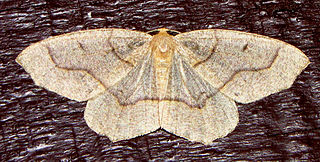
Lambdina fiscellaria, the mournful thorn or hemlock looper, is a moth of the family Geometridae. It is found in North America, from the Pacific to the Atlantic coast and from Canada south to Pennsylvania, Wisconsin and California.

Abagrotis alternata, the greater red dart or mottled gray cutworm, is a moth of the family Noctuidae. The species was first described by Augustus Radcliffe Grote in 1865. It is found in eastern North America, from New Brunswick west across southern Canada to western Alberta, south to Arizona, New Mexico and the Gulf of Mexico.

Euclidia cuspidea, the toothed somberwing, is a moth of the family Erebidae. The species was first described by Jacob Hübner in 1818. It is found in North America from Quebec west to western Alberta, north to the Northwest Territories and south to the Gulf of Mexico.
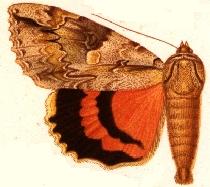
Catocala parta, the mother underwing, is a moth of the family Erebidae. The species was first described by Achille Guenée in 1852. It is found in North America from Nova Scotia south to Maryland and Kentucky, west to southern Saskatchewan and Alberta, western Montana, and Utah. The wingspan is 70–78 mm. Adults are on wing from August to September depending on the location.

Catocala briseis, the Briseis underwing or ribbed underwing, is a moth of the family Erebidae. The species was first described by William Henry Edwards in 1864. It is found across the North American Boreal forest region from Newfoundland to the Pacific, south to Massachusetts and Pennsylvania.
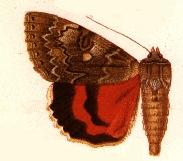
Catocala californica is a moth of the family Erebidae first described by William Henry Edwards in 1864. It is found in western North America from British Columbia and Alberta south through Washington and Oregon to California.

Catocala hermia, the Hermia underwing, is a moth of the family Erebidae. The species was first described by Henry Edwards in 1880. It is found throughout the Great Plains of North America, from southern Saskatchewan and Alberta south and west to Texas, Arizona and California.

Catocala junctura, the joined underwing or Stretch's underwing, is a moth in the family Erebidae. The species was first described by Francis Walker in 1858. It is found throughout temperate North America, ranging from New York and Pennsylvania west to Montana, Colorado, Oklahoma, Arizona, and into Texas, and north to southern Illinois, extreme southern Alberta and Saskatchewan; it has also been recorded west of the Rocky Mountains from California and south-eastern British Columbia. It is typically found near water, where the food plants of its caterpillar larvae grow plentifully.
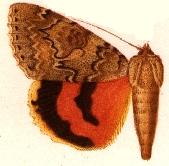
Catocala luciana, the shining underwing, is a moth of the family Erebidae. The species was first described by Herman Strecker in 1874. It is found in western North America, as far east as Minnesota and Illinois and northward into extreme southern Alberta and Saskatchewan. It occurs widely across the Great Plains, south to New Mexico, Arizona and California.

Caenurgina is a genus of moths in the family Erebidae.

Caenurgina crassiuscula, the clover looper or range grass moth, is a moth of the family Erebidae. The species was first described by Adrian Hardy Haworth in 1809. It is found from coast to coast in the United States and adjacent parts of Canada, in the west to the Northwest Territories, Yukon, and Alaska.

Caenurgina erechtea, the forage looper or common grass moth, is a moth of the family Erebidae. The species was first described by Pieter Cramer in 1780. It is found from coast to coast in the United States and adjacent parts of Canada. It is not found in Newfoundland, New Brunswick, Prince Edward Island, Yukon, or the Northwest Territories. The wingspan is 30–42 mm. Adults are on wing from March to November depending on the location.
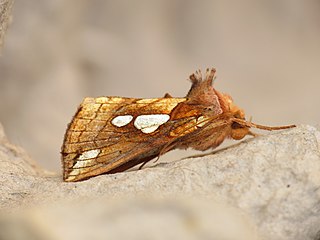
Plusia putnami, the Lempke's gold spot or Putnam's looper moth, is a species of moth of the family Noctuidae. It is found in the Palearctic realm, from Japan and eastern Siberia to Fennoscandia, Great Britain, and France. In North America, it ranges from Newfoundland and Labrador to central Alaska and the interior of British Columbia, south to Pennsylvania, Washington, north-eastern California, and in the Rocky Mountains to Utah and Colorado.

Drasteria adumbrata, the shadowy arches, is a moth of the family Erebidae. The species was first described by Hans Hermann Behr in 1870. It is found from coast to coast in southern Canada, south in the west to California and Colorado, south in the east to New England and Michigan. Subspecies D. a. alleni is found from eastern Alberta to New York and Nova Scotia. Subspecies D. a. saxea occurs from southern British Columbia and south-west Alberta south to California and Colorado.
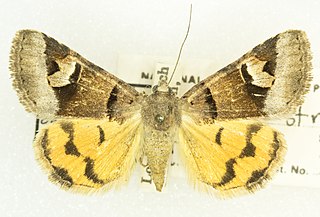
Drasteria perplexa, the perplexing or perplexed arches, is a moth of the family Erebidae. The species was first described by Henry Edwards in 1884. It is found in North America from Alberta and Saskatchewan south to Colorado and Arizona.

Heliothis oregonica, the Oregon gem, is a moth of the family Noctuidae. The species was first described by Henry Edwards in 1875. It is found in North America from the Peace River area of Alberta south and west in the mountains to California and Arizona. There is also a disjunct population in north central Quebec.

Aspitates aberrata is a species of moth in the family Geometridae that was first described by Henry Edwards in 1884. It is found in North America from northern Minnesota north and west across southern Manitoba to western Alberta and the Peace River area of British Columbia. The habitat consists of open aspen parklands and low elevation grasslands.

Macaria aemulataria, the common angle moth, is a moth in the family Geometridae. The species was first described by Francis Walker in 1861. It is found from Nova Scotia to Florida, west to Texas, north to Oregon and Alberta.















